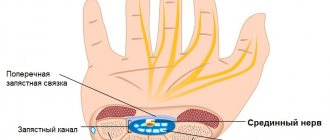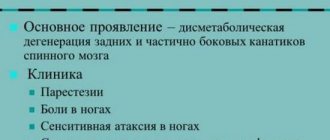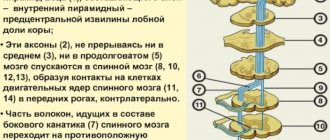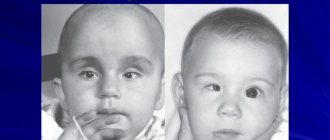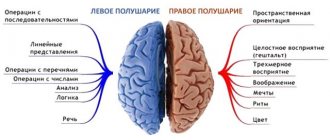With various brain lesions, complexes of characteristic disorders called syndromes develop. One of them is pseudobulbar palsy. This condition occurs when the nuclei of the medulla oblongata cease to receive sufficient regulation from overlying centers. It does not pose an immediate threat to the patient's life, unlike bulbar palsy. Correct differential diagnosis between these two syndromes not only allows the doctor to determine the level of damage, but also helps to assess the prognosis.
Pathogenesis
Normally, every person in the brain has so-called “old” parts that work without his control. The syndrome appears when failures occur in the regulation of the movement of impulses from the nerve nuclei. Loss of impulses is possible with brain pathology. In this case, the kernels begin to work in emergency mode, causing the following processes:
- Change in articulation. There is a violation of the pronunciation of many sounds.
- Problems with swallowing due to the development of paralysis of the soft palate.
- Activation of oral automatism reflexes, which should normally be present in newborns.
- The appearance of an involuntary grimace.
- Impaired phonation and decreased mobility of the vocal cords.
Often, deviations in the functioning of the nervous system are caused not only by damage to the nuclei, but also by changes in the brain stem and cerebellum. In newborns, the disorder is usually bilateral, which increases the risk of cerebral palsy.
Treatment of pseudobulbar syndrome
In the course of treatment, basic medical procedures and prescriptions are aimed at eliminating the root cause that provoked the pathological syndrome:
- When the disease is triggered by hypertension, the doctor prescribes a course of therapy aimed at reducing blood pressure and normalizing the cardiovascular system.
- If vasculitis is diagnosed when syphilis or pulmonary tuberculosis is diagnosed, a course of antibacterial compounds is prescribed.
- Drugs are prescribed that improve blood flow and nutrition to the brain, normalize the functioning of the central and peripheral nervous systems.
Note! There is no classical treatment plan - it is compiled taking into account the general condition of the patient, the stage of the disease, and concomitant disorders. Special gymnastic exercises and physiotherapeutic procedures - massage and electrophoresis - also work well.
Difference from bulbar syndrome
Bulbar palsy is a whole group of different disorders that arise due to damage to the nerve nuclei. Such centers are located in a special part of the medulla oblongata – the bulba, which is where the name of the disorder comes from. With pathology, paralysis of the soft palate and pharynx occurs, which is often accompanied by disruption of vital functions.
nerves affected in bulbar syndrome
Pseudobulbar differs in that the nuclei do not stop functioning, even when the connection between them and the nerve endings is disrupted. At the same time, the muscles remain unchanged.
In both cases, chewing, swallowing and articulation suffer, despite the fact that the mechanisms of development of these pathologies also differ from each other.
Reasons for the development of the syndrome
The pathology occurs due to impaired coordination of neurons in the brain. The following conditions can lead to this disorder:
- Hypertension with hemorrhagic foci, multiple strokes;
- Blockage of blood vessels;
- Various degenerative disorders;
- Complications of intrauterine, birth or traumatic brain injury;
- Ischemic disease after coma or clinical death;
- Inflammatory processes in the brain;
- Benign and malignant tumors.
Also, pseudobulbar syndrome can occur due to exacerbation of chronic diseases.
Vascular diseases
One of the most common causes of the occurrence and development of pseudobulbar syndrome is vascular blockage. Multiple ischemic lesions, hypertension, vasculitis and atherosclerosis, heart and blood diseases can lead to pathology. The risk increases especially in people over 50 years of age. Typically, such disorders are detected using MRI.
Congenital bilateral aqueduct syndrome
This disorder is characterized by impaired speech and mental development in children. In rare cases, the disease can develop into autism or pseudobulbar syndrome. Doctors also record regular attacks of epilepsy (about 80% of all cases). To make a correct diagnosis, an MRI is necessary.
Brain injuries
Any severe traumatic brain injury can lead to the development of pseudobulbar syndrome with swallowing and speech disorders. This occurs due to mechanical damage to brain tissue and multiple hemorrhages.
Degenerative diseases
Most of these conditions are also accompanied by pseudobulbar palsy. Such disorders include: primary lateral and amyotrophic sclerosis, Pick's disease, Parkinson's disease, Creutzfeldt-Jakob disease, multiple system atrophy and other extrapyramidal disorders.
Consequences of encephalitis and meningitis
Meningitis and encephalitis can also lead to the onset and development of the syndrome. In this case, doctors identify symptoms of an infectious brain lesion. In this case, the threat to the patient’s life is especially high.
Encephalopathy
Pathology usually occurs in patients who have recently experienced clinical death, resuscitation measures, or have been in a comatose state for quite a long time.
The disease can lead to the development of pseudobulbar palsy, especially due to severe hypoxia.
Development of pathology in children
Typically, the disorder in infants becomes noticeable within a few days after birth. Sometimes experts establish the simultaneous presence of bulbar and pseudobulbar palsy. The disease occurs as a result of thrombosis, amyotrophic sclerosis, demyelinating processes or tumors of various etiologies.
Treatment
First of all, differential diagnosis is necessary to exclude bulbar syndrome, parkinsonism, nephritis, and neuroses.
There is no universal pill or injection that cures this disease. Each patient requires an individual approach. The doctor will select the necessary medications taking into account the condition of each individual patient.
It is important to fight the disease that has become the root cause of pseudobulbar syndrome. Appropriate treatment is selected for each patient. At the same time, the syndrome itself is treated.
A whole list of medications can be used to relieve symptoms and restore muscle function:
- To improve the transmission of nerve impulses, blood supply to the brain (Cerebrolysin, Aminalon);
- drugs to strengthen the walls of blood vessels;
- metabolic agents that improve metabolic processes in brain tissue;
- nootropic drugs (nootropil, pantogam);
- drugs for the breakdown of acetylcholine (prozerin, oxazil).
In addition to medications, the patient is prescribed physiotherapy, massage, physical therapy, breathing exercises, and a rehabilitation course to restore speech. In severe cases, physiotherapy and massage are combined with medications and acupuncture.
Modern medicine also suggests using stem cells for treatment. The principle of their action is associated with the replacement of affected cells with healthy ones. This is an expensive and complex procedure, which is resorted to in rare cases.
Signs of the disease
Pseudobulbar syndrome is characterized by speech and swallowing disorders at the same time. Signs of oral automatism and violent grimaces also appear.
patient with pseudobulbar syndrome
The patient's speech problems dramatically affect the pronunciation of words, diction and intonation. There is a “loss” of consonants, the meaning of words is lost. This phenomenon is called dysarthria and is caused by spastic muscle tone or paralysis. In this case, the voice becomes dull, quiet and hoarse, and dysphonia occurs. Sometimes a person loses the ability to speak in a whisper.
Problems with swallowing are explained by weakness of the muscles of the soft palate and the pharynx itself. Food often gets stuck behind the teeth and on the gums, and liquid food and water leak out through the nose. But at the same time, atrophy and muscle twitching do not bother the patient, and the pharyngeal reflex often even becomes increased.
Signs of oral automatism usually go unnoticed by the patient. Most often, for the first time they make themselves felt during a medical examination by a neurologist. Thanks to the impact on certain areas, the doctor detects contraction of the muscles of the mouth or chin. Typically, the reaction becomes noticeable when you tap your nose or press the corner of your mouth with a special instrument. Also, patients' masticatory muscles react to a light tap on the chin.
Forced crying or laughter is short-lived. Facial expressions change involuntarily, regardless of a person’s real feelings or impressions. The muscles of the entire face are often affected, as a result of which it becomes difficult for the patient to squint his eyes or open his mouth.
Pseudobulbar palsy does not appear out of nowhere. It develops together with other neurological disorders. The symptoms of the disease directly depend on the root cause of the disease. For example, damage to the frontal part of the head is characterized by an emotional-volitional disorder. The patient becomes inactive, lethargic, or, conversely, overly active. Motor and speech disorders may occur, and memory deterioration may occur.
Symptoms
One of the main symptoms of this disease includes impaired swallowing and chewing. In this condition, food begins to get stuck on the gums and behind the teeth, liquid food can flow out through the nose, and the patient often chokes during meals. Moreover, changes occur in the voice - it takes on a new shade. The sound becomes hoarse, consonants drop out, and some intonations are completely lost. Sometimes patients lose the ability to speak in a whisper.
With a problem such as pseudobulbar syndrome, symptoms can also be expressed through bilateral paresis of the facial muscles. This means that the face takes on a mask-like, anemic appearance. It is also possible to experience attacks of violent convulsive laughter or crying. But such symptoms are not always present.
It is worth mentioning the tendon reflex of the lower jaw, which can increase sharply during the development of the syndrome.
Often pseudobulbar syndrome is recorded in parallel with a disease such as hemiparesis. Extrapyramidal syndrome may occur, which leads to stiffness, increased muscle tone and slowness of movement. Intellectual impairment, which can be explained by the presence of multiple foci of softening in the brain, is also possible.
Moreover, unlike the bulbar form, this syndrome excludes the occurrence of disorders of the cardiovascular and respiratory systems. This is explained by the fact that pathological processes do not affect the vital centers, but develop in the medulla oblongata.
The syndrome itself can have either a gradual onset or an acute development. But if we consider the most common indicators, it can be argued that in the vast majority of cases, the appearance of pseudobulbar syndrome is preceded by two or more attacks of cerebrovascular accident.
Diagnostics
To confirm pseudobulbar syndrome, differential diagnosis should be made from bulbar syndrome, neuroses, parkinsonism and nephritis. One of the most important signs of the pseudoform of the disease is the absence of muscle atrophy.
It should also be noted that the syndrome is similar in its characteristics to Parkinson-like paralysis. The patient, as with pseudobulbar disorder, experiences speech impairment and violent crying. This pathology proceeds slowly, and in the final stages leads to apoplexy strokes. That is why it is important to seek help from a qualified and experienced doctor as early as possible.
Prevention
Prevention of this disorder consists of preventing serious illnesses that can cause paralysis.
Prevention of pseudobulbar syndrome includes the identification and treatment of cerebral atherosclerosis and the prevention of strokes.
It is necessary to adhere to a work-rest regime, limit caloric intake, reduce the consumption of animal proteins and foods with cholesterol. There is no specific prevention.
It is very important to immediately contact a specialist who will not only select the correct treatment, but also help reduce the manifestations of the disorder in order to improve the patient’s quality of life.
Therapy for paralysis
Pseudobulbar syndrome does not appear out of nowhere - it comes in response to an underlying disease. Therefore, when treating paralysis, it is necessary to defeat the root cause of the disease in both adults and children. For example, to influence hypertension, experts prescribe vascular and antihypertensive therapy.
In addition to the main cause of the syndrome, attention should also be paid to normalizing the functioning of neurons and improving blood circulation in the brain (Aminalon, Encephabol, Cerebrolysin). Metabolic, vascular, nootropic (“Nootropil”, “Pantogam”) and acetylcholine-breaking agents (“Oxazil”, “Proserin”) will help cope with the disease.
Unfortunately, there is no single drug for the treatment of paralysis yet. The specialist must draw up a specific set of therapy, taking into account all the existing pathologies in the patient. Moreover, in addition to drug treatment, it is necessary to add breathing exercises, exercises for all affected muscles, and physiotherapy.
Also, in case of incorrect pronunciation of words, patients should take a course of classes with a speech pathologist. This therapy will be especially useful for children. This will make it easier for the child to adapt to school or another educational institution.
The chances of improving your health will increase significantly if you use stem cells to treat your illness. They are capable of triggering the replacement of the myelin sheath, which will lead to restoration of the functioning of damaged cells.
How to influence the condition in infants
If pseudobulbar palsy occurs in a newborn child, it is necessary to begin comprehensive treatment as soon as possible. It usually includes: feeding the child through a tube, massage of the mouth muscles and electrophoresis in the cervical spine.
We can talk about improving the general condition of the baby only when the child begins to develop reflexes that were absent before; the neurological condition is stabilized; there will be positive changes in the treatment of deviations that were previously established. Also, the newborn should increase motor activity and muscle tone.
Infant rehabilitation
When incurable lesions are not detected in a newborn, usually the recovery process begins already during the first two weeks of the baby’s life. If pseudobulbar palsy is detected, treatment occurs in the fourth week and necessarily requires rehabilitation. For children who have suffered seizures, doctors select medications especially carefully. Cerebrolysin is usually used (about 10 injections). And to maintain the body, Phenotropil and Phenibut are prescribed.
Massage and physiotherapy
As an additional therapy that will speed up the process of recovery and rehabilitation, specialists prescribe therapeutic massage and physiotherapy.
The massage should be performed strictly by a professional and have a predominantly tonic and sometimes relaxing effect. Even children can carry out such procedures. If a child has spasticity of the limbs, it is better to start procedures already on the tenth day of life. The optimal course of therapy is 15 sessions. At the same time, it is recommended to take the Mydocalma course.
Physiotherapy usually involves magnesium sulfate electrophoresis with aloe applied to the cervical area.
Pseudobulbar dysarthria
This is one of the neuralgic disorders that is a consequence of pseudobulbar palsy. The disease occurs due to disruption of the pathways that connect the bulbar pulp to the brain. Pathology can have 3 degrees:
- Easy. Almost invisible, characterized by unclear pronunciation of many sounds in children.
- Average. The most common. Almost all facial movements become impossible. It is uncomfortable for patients to swallow food, and the tongue is inactive. Speech becomes slurred and unclear.
- Heavy. The patient cannot control his facial expressions, and the mobility of the entire speech apparatus is impaired. Patients often have a drooping jaw and a stiff tongue.
Treatment of pathology is only possible through a combination of medications, massage and reflexology at the same time. The syndrome poses a huge danger to human life, so delaying treatment is highly discouraged.
How to influence the condition in newly born children
If pseudobulbar syndrome has been diagnosed in newborns, treatment will involve an integrated approach. First of all, this is a massage of the orbicularis oris muscle, feeding through a tube and electrophoresis with proserin on the cervical spine.
Speaking about the first signs of recovery, it is worth noting that they include the appearance of reflexes of the newborn, which were previously absent, stabilization of the neurological status and positive changes in the deviations recorded earlier. Also, with successful treatment, there should be an increase in motor activity against the background of physical inactivity or an increase in muscle tone in the case of severe hypotension. In children with long gestational ages, a meaningful reaction to contact and emotional tone improves.
Forecast
Unfortunately, it is almost impossible to completely get rid of pseudobulbar palsy. The pathology affects the brain, as a result of which many neurons die and nerve pathways are destroyed. But adequate therapy can compensate for the resulting disorders and improve the general condition of the patient. Rehabilitation measures will help the patient adapt to emerging problems and adapt to life in society. Therefore, you should not neglect the recommendations of a specialist and postpone treatment. It is important to preserve nerve cells and slow down the development of the underlying disease.
© sindrom.info
Goals and methods of therapy
Sometimes the patient requires emergency medical care to save his life with bulbar palsy.
Its main goal is to eliminate the threat to life before transporting the patient to the hospital, where adequate treatment will then be prescribed.
Depending on the nature of the pathology and clinical symptoms, the doctor is able to predict the effectiveness of treatment of the disease, as well as its outcome.
This process consists of several stages, the first of which is the resuscitation and support of functions impaired due to paralysis.
To restore breathing, artificial ventilation is performed, and vitamins, adenosine triphosphate and proserine are prescribed to trigger the swallowing reflex. Atropine is used to reduce salivation.
The next step of treatment is symptomatic therapy, which can alleviate the general condition of the patient , and then comes the direct treatment of the disease that caused the development of the syndrome.
Since the patient is not able to eat on his own, he is fed through the use of an enteral feeding tube.
